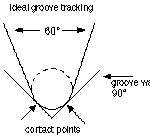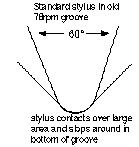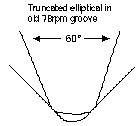VADLYD MD12 MK4
Multicurve Disc preamp
78 RPM and RIAA Record Preamplifier
It is with regret that we have to announce that the VADLYD MD12 is no longer in production. It has been very difficult to make this decision, but due to circumstances that have occurred, it has been a necessary decision.
NOT IN STOCK

VADLYD MD12 MK4 includes as standard vertical/lateral switch, and switchable inputs for MM/MC cartridges. MC inputs are with 3 switchable load impedances: 50, 100, and 200 ohms.
Recording engineers and serious record collectors know the problem when playing early phonograph records: ordinary RIAA phono equalization does not always match the original recording equalization that was used to make the record.
78rpm records in particular have many different eq settings depending on period, placement, and recording company. Even within the same company, there may be differences depending on which engineer was on job that day.
The VADLYD MD12 MK4 is a product with professional specifications, but it is also useful for record collectors who want the proper playback equalization of early phonograph recordings, particularly 78rpm records.
Overview:
- 12 presets enable adjustment to nearly all eq curves: 8 presets for 78s, and 4 presets for 33/45s
- Excellent sound quality
- Switches for Stereo, Mono L + R, Mono L or Mono R
- Switch for Vertical Cut records (Path/Edison)
- Volume and balance controls, suitable to drive a power amplifier directly
- VCA controlled potmeters, which means better channel balance overall in the potmeter range
- Multiple LEDs for easy operation
- One set of outputs is balanced with XLR connectors, with a second set providing unbalanced output on RCA phono jacks (new). This allows for both professional and consumer use
- The third set of outputs is also balanced with XLR connectors, but it contains a flat output signal. This signal is not affected by the eq settings and is useful for making simultaneous, archival transfers per Paragraph 5.2.6.7 of IASA-TC04, Guidelines on the Production and Preservation of Digital Audio Objects
- 19 wide suitable for mounting in one rack (1.75 high) space, or it may be placed on a flat surface close to your turntable
- Two identical inputs, making it possible to have two turntables connected at the same time
- Each input is switchable for moving magnet (MM) or moving coil (MC) phono cartridges. Input impedance for MM cartridge is standard 47 kOhm. MC inputs have 3 switchable load impedances: 50, 100, or 200 Ohm
- Front panel headphone jack with dedicated volume control
- Improved back panel grounding screw
- Internal power supply (no external power supply)
A few words concerning long life of all electronic equipment: most potentiometers can stand severe wear for decades, but dust – and especially smoke – can make them noisy in a very short time. Tobacco smoke is ALMOST as dangerous for a pot as it is for your health!
ABOUT PHONO PREAMPLIFIERS
When playing phonograph records, you might normally use the phono input provided on your amplifier, often called a RIAA (Recording Industries Association in America) phono input.
The RIAA equalization curve specifies two turnover points (a turnover point is where the level changes 3dB): one at 500Hz, and the other at 2125Hz. The RIAA playback curve has the following theoretical response:
1. +17dB from 20Hz to 50Hz, then falling about 6dB/octave to
2. 0dB from 500Hz to 2125Hz, and then falling again about 6dB/octave to
3. -13.7dB at 10kHz.
You use the RIAA playback curve to compensate for the RIAA equalization that was originally used to make the record.
Normally this works well on single, EP and LP records, issued from 1955 and later. But with earlier LPs (some record companies didnt use RIAA before 1960), this curve is not correct. The cutting equalizations on all 78 RPMs and LPs before 1955 have been very different. 78rpm records in particular used curves very different from the RIAA curve. For this reason, you should not use the RIAA phono input on your amplifier if you want good quality reproduction of 78rpm records.
I want to thank Roger Wilmut for basic information about reproduction of 78rpm records. For a better understanding of the problems of reproduction of records, read the following articles (with a few edits from my hand) taken with kind permission from Roger Wilmuts home page: Reproduction of 78rpm records – www.rfwilmut.clara.net/repro78/repro.html.
EQUALIZATION OF PHONOGRAPH RECORDS
The simplest form of disk cutter consists of an amplifier, similar to that used to drive a loudspeaker, connected to a cutting head having a stylus connected to a coil, which is placed in the field from a strong magnet (or, more usually in later designs, a magnet within a coil). When the signal is applied to the coil, the stylus moves and engraves a groove in the blank disk. (There is of course a lot more to it than that, but we are considering only the basics here.)
However, because the cutter heads movements translate the amplitude swings of the original signal into velocity – the rate at which the stylus moves during its swings – low-frequency signals would be recorded with a much larger swing than high-frequency signals of the same original amplitude. In order to keep the movements of the groove much the same at all frequencies (given equal level signals) it is necessary to use a circuit to introduce – in the theoretical situation – a 6 dB/octave cut as the frequency decreases – i.e., halve the frequency and you halve the voltage.
In the reverse situation, that of a reproduction head, the principal is that of a wire moved in a magnetic field – it is the rate of cutting lines of force that matters. The cutter head works exactly in reverse, like a simple motor, where increased voltage means increased speed. Therefore, the constant amplitude groove theoretically achieved produces a signal where the bass is low and the treble high: so a 6 dB/octave cut with increasing frequency would be called for.
In the real world, losses in the head with increased frequency complicate the issue. Early cutter heads were highly inefficient, and so, while the bass cut described above was used, the treble trailed away, resulting in equal groove modulations (movements) up to mid frequencies, but decreasing above that.
To compensate for this, the playback characteristic boosted the bass below 200 Hz but left it flat above that – effectively providing a 6 dB/octave boost to the higher frequencies (and the surface noise). With the later improvements in cutters, it was possible to pack more treble onto the records, and so new equalizations provided for a 6 dB/octave cut above a turnover frequency which varied between 3.4 and about 6 kHz, depending on the system.
Boosting the treble during recording had the effect of reducing the surface noise during playback. It was also common to flatten out the bass at the very lowest frequencies to reduce the boost of rumble from the turntable.
Similar techniques were applied to microgroove records, and the final standard, RIAA, provides for a bass boost below 500 Hz and a treble cut above the lower frequency of 2,212 kHz – the latter reflecting the considerably increased amount of treble which can be cut onto an LP.
Therefore playing a 78rpm record using RIAA equalization – all that is available to many people – produces far less top end response than is correct, particularly for the earliest electrical records, where the result is akin to turning the treble control down. (Turning the treble up gives an improvement, but it doesnt touch the important mid-range.)
Use of the correct eq curves when reproducing 78rpm records produces a startling improvement in the sound quality (although admittedly the surface noise can increase).
Many of these older recordings are of surprisingly high quality after all!
STYLUS SELECTION
At the time the format disappeared as a popular format, the recommended stylus size was 60 (0.0025) conical tip. This would be satisfactory for records made in the final few years, but for the great majority of the time since the beginning of 78s in 1896 the grooves were much wider than the standard, with the result that a 60 stylus skates about in the bottom of the groove, seriously increasing the surface noise.
The basic stylus is conical, with a spherical tip; the included angle of the cone is 60 degrees. Most modern styli are elliptical: i.e. they look the same from the front, but from the side they have a much narrower angle. This enables them to track movements in the groove more easily (as the groove moves from side to side it effectively narrows – not across its direct width but across the diameter of the conical tip, at an angle to the direction of travel: consequently a spherical tip will ride up in the groove).
The illustrations below could apply equally to a spherical tip and an elliptical tip seen from the front: in practice I would always recommend elliptical.

A modern record groove should be a neat 90 degrees, with the stylus making contact at only two points part-way up the groove wall, thus avoiding any debris in the bottom of the groove. (Some modern microgroove styli have a flat section at the contact point, giving a wider area of contact which reduces wear: however it can also increase noise from worn or damaged groove walls and I would be dubious about its use for 78s).
However older 78s were cut to be used with steel needles, on the assumption that the needle would wear down to fit the groove in the first few seconds: when this wider groove is tracked with a 2.5 thou stylus the result is bottoming as can be seen here.


Here the combination of a larger basic size: 70 (0.0028) works on the majority of records, although larger sizes may be helpful with very old records – and the truncated tip (which is spherical down to the contact points but truncated below) result in vastly better tracking. Like LPs, Records in good condition, will be better reproduced If the stylus is elliptical. This brings a considerable improvement in distortion and will be with reduced surface noise and greater analysis. With records in poor condition, you often will have a better reproduction with conical styli.
Professional mastering engineers and serious collectors often have a collection of styli sizes, conical truncated as well as elliptical truncated. A good starting point could be:
Records from | Conical truncated | Eliptical truncated |
Before 1920: | 100 (0.0040″) | 100 x 30 (0.0040″ x 0.0012″) |
1920 – 1939: | 90 (0.0035″) | 90 x 30 (0.0035″ x 0.0012″) |
1939 – : | 70 (0.0028″) | 70 x 25 (0.0028″ x 0.0009″) |
A good address for buying cartridges and styli, as well as retipping of styli, is
Expert Stylus Company
P.O. Box 3 – Ashtead
Surrey KT21 “QD – England
Tel: +44 01372 276604
SPEED SELECTION
Not all 78s were actually recorded at 78 rpm. Even in the late 1920s, English Columbia was still using 80 rpm, and prior to about 1921 speeds were widely variable. Speeds as low as 68 or as high as 84 rpm are not uncommon.
To make matters worse, relatively few 78rpm records state the speed (and when they do its not always accurate). If the work is a classical piece such as an opera aria, it is possible to check the correct pitch against a score or a modern recording. However, as occasionally singers would transpose, even this isn’t completely reliable. My best recommendation is to gradually reduce the speed of a record until it starts to sound sluggish, and then increase it slightly (in my experience the ear is much more sensitive to low speeds than high speeds).
Finding a turntable capable of coping with these speeds is often a challenge. I dont know of any normally available turntable which has more than a tiny variation (usually 2 or 3 %), which is nowhere near enough); but electronically controlled turntables may be modifiable. You need a speed range of 72 to 82 to cover most records.
